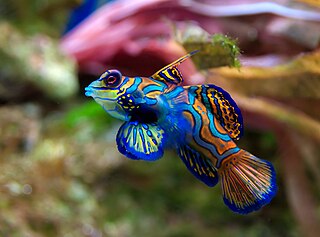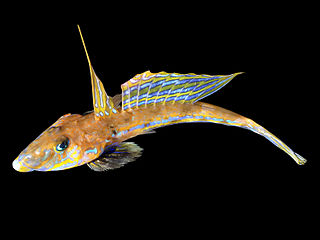
Dragonets are small, percomorph, marine fish of the diverse family Callionymidae found mainly in the tropical waters of the western Indo-Pacific. They are benthic organisms, spending most of their time near the sandy bottoms, at a depth of roughly two hundred meters. There exist 139 species of the fish, in nineteen genera.

Charles Tate Regan FRS was a British ichthyologist, working mainly around the beginning of the 20th century. He did extensive work on fish classification schemes.

Synchiropus splendidus, the mandarinfish or mandarin dragonet, is a small, brightly colored member of the dragonet family, which is popular in the saltwater aquarium trade. The mandarinfish is native to the Pacific, ranging approximately from the Ryukyu Islands south to Australia. It can usually be found in some of the warmer waters.

Callionymus is a genus of dragonets found mostly in the Indian and Pacific oceans with a few species occurring in the Atlantic Ocean.

The common dragonet is a species of dragonet which is widely distributed in the eastern North Atlantic where it is common near Europe from Norway and Iceland southwards. It is a demersal species that occurs over sand bottoms. It lives to a maximum age of around seven years. It is caught in bycatch by fisheries and is used in the aquarium trade.
The spotted dragonet is a species of dragonet native to the eastern Atlantic Ocean and the Mediterranean Sea where it occurs at depths of from 45 to 650 metres. This species is important to local peoples engaged in subsistence fishing.
Spinicapitichthys spiniceps, the Seychelles spiny dragonet, is a species of dragonet known only from the waters around the Seychelles where it is found in weed beds. This species grows to a length of 15.2 centimetres (6.0 in) TL. It is the only species in the monotypic genus Spinicapitichthys which was previously considered to be a subgenus of the large genus Callionymus.

Synchiropus is a genus of fish in the family Callionymidae found mainly in the tropical waters of the Indo-Pacific region.
Draculo is a genus of dragonets found mainly in the tropical waters of the western Indo-Pacific.

The Japanese dragonet is a species of dragonet native to the northwestern Pacific Ocean, where it is known from the waters off of Japan and South Korea. It can be found on coral or rocky reefs at depths of 10 to 20 metres, in preferred water temperatures of 18 to 22 °C. It is also found in the aquarium trade. This species reaches a length of 7 centimetres (2.8 in) SL and 10 centimetres (3.9 in) TL.
The Kai Island deepwater dragonet is a species of dragonet native to the Indian Ocean and the western Pacific Ocean, from Zanzibar and the coast of East Africa to the western Pacific Ocean including southern Japan, the East China Sea and the Banda Sea. It is the only species in the monotypic genus Bathycallionymus. This species was formally described in 1880 as Callionymus kaianus by the German-born British zoologist Albert Günther with from a type collected off Kai Island in the Banda Sea during the Challenger expedition of 1872–Callionymus.

Diplogrammus is a genus of dragonets.
Eleutherochir is a monotypic genus of dragonets native to the Indian Ocean and the western Pacific Ocean.
The painted stinkfish or painted dragonet is a species of dragonet endemic to the Indian Ocean coasts of Australia and Tasmania where it is found at a depth of about 50 metres (160 ft). This species grows to a length of 10 centimetres (3.9 in) TL. This species is the only known member of its genus.
Protogrammus is a genus of dragonets found in the Atlantic and Pacific Oceans.

Pseudocalliurichthys variegatus, the variegated ruddertail dragonet , is a species of dragonet native to the western Pacific off southern Japan where it can be found in beds of Zostera sea grass, on sandy sea beds and among reef rubble. This species grows to a length of 10 centimetres (3.9 in) SL. This species is the only known member of its genus.
Repomucenus is a genus of dragonets native to the Indian Ocean and the western Pacific Ocean. This genus also includes one freshwater species (R. olidus).

Callionymus izuensis, the Izu dragonet, is a species of dragonet which is endemic to the waters around the Izu Islands of Japan. It is found at depths of 16–18 metres (52–59 ft) over substrates consisting of coarse sand, although sometimes coral rubble and broken shells may form part of the habitat. It was originally described as a subspecies of Callionymus persicus from the western Indian Ocean and has also been placed in the genus Calliurichthys by some authorities.

Callionymiformes is an order of bony fish containing two families, the dragonets Callionymidae and the Draconettidae. In some taxonomies these families make up the suborder Callionymoidei of the wider grouping known as Perciformes, Nelson (2016) recognised the order but subsequent workers have suggested that if Callionymiformes is recognised as an order then the order Syngnathiformes is rendered paraphyletic and include Callionmyoidei within that taxon.
Synchiropus novaehiberniensis, the New Ireland dragonet, is a species of fish in the family Callionymidae, the dragonets. It is found in the western Pacific Ocean.









